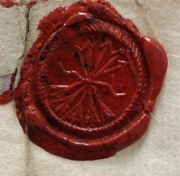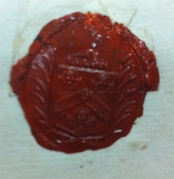Last October I had the chance to go to Care and Conservation of Manuscripts 14 in Copenhagen. It was an amazing experience and full of exciting sessions and events, but one of my very favourites was given by Ilona Teplouhova of the National Archives of Latvia on the conservation of wax seals in Latvia. In addition to introducing me to the interesting field of sphragistics (or sigillography), it was an excellent overview of some of the conservation concerns regarding wax seals which I have found incredibly useful while I’ve been processing the Bulstrode Newsletters collection.
Sphragistics started out as an ancillary discipline to dipomatics, the scholarly study of historical documents. Because most wax seals depict a coat of arms, it has strong links to the study of heraldry and genealogy, art history, and social history. Because the seals were made of wax, they’re often quite brittle now that the wax has set and hardened. In the Bulstrode collection, all of the seals were used to securely close the newsletters and many of them, therefore, have either been broken or are attached to torn pieces of paper.
Going into processing the collection, I knew that there would be a variety of wax seals to examine: the Pforzheimer catalogue notes that Edward Coleman used a seal of “on a chevron between three cherubs heads winged, a crescent for difference” in either red or black wax. Whether this was Coleman’s personal coat of arms, I’m not sure—Coleman was employed by Mary of Modena, the Duchess of York, during his tenure as a newsletter-writer, and this seal doesn’t seem to correspond to anything connected with the Duchess. The seal of the three cherubs is ubiquitous across Coleman’s letters, appearing on a significant number of the newsletters he sent to Richard Bulstrode.
 Among the newsletters sent from Sir Joseph Williamson’s office, there are (at least) eleven different seals to be found including three roundels on a fess between three crosses; a ship; what I believe is a female peacock; on a chevron engrailed between three crosses clechée fitched; a sheaf of five arrows, tied; a compass rose of sixteen points; three roundels on a chevron between three birds; three lions heads on a bend; and the most common, a chevron between three water-bougets.
Among the newsletters sent from Sir Joseph Williamson’s office, there are (at least) eleven different seals to be found including three roundels on a fess between three crosses; a ship; what I believe is a female peacock; on a chevron engrailed between three crosses clechée fitched; a sheaf of five arrows, tied; a compass rose of sixteen points; three roundels on a chevron between three birds; three lions heads on a bend; and the most common, a chevron between three water-bougets.
 Most of the seals in the Williamson letters only appear once or twice, and I haven’t been able to determine if any of the seals belong to any of the seven named newsletters writers who worked for Williamson. Robert Yard, Wiliamson’s right hand man and general manager of the newsletter office, has signed his name to letters with two different seals. I can’t find any indication that either Robert Yard or Edward Coleman were allowed to bear a coat of arms, but if the seals aren’t connected to the writers and employees of the newsletter offices, I’m not sure what they’re doing affixed to the newsletters at all. Given the abundance of different forms among the Williamson letters, I know they don’t all belong to him. But who?
Most of the seals in the Williamson letters only appear once or twice, and I haven’t been able to determine if any of the seals belong to any of the seven named newsletters writers who worked for Williamson. Robert Yard, Wiliamson’s right hand man and general manager of the newsletter office, has signed his name to letters with two different seals. I can’t find any indication that either Robert Yard or Edward Coleman were allowed to bear a coat of arms, but if the seals aren’t connected to the writers and employees of the newsletter offices, I’m not sure what they’re doing affixed to the newsletters at all. Given the abundance of different forms among the Williamson letters, I know they don’t all belong to him. But who?
 I can’t spend a whole lot of time cataloguing the seals or attempting to identify any of families they belong to, although I’m still keeping detailed notes and attempting to research the correct way to describe them for my own future reference. My supervisor gave me permission to include a note about whether a complete or partial seal appears on a letter in the database, and she’s made notes for the digitization team to be sure to capture an image of every seal and include it with the images of the letters. Some day I hope to go back and add descriptions, and possibly identifications as well if I can work with the College of Arms to try and identify coats of arms that go back so far. For now I’m most concerned with making sure that the seals aren’t in imminent danger of destruction.
I can’t spend a whole lot of time cataloguing the seals or attempting to identify any of families they belong to, although I’m still keeping detailed notes and attempting to research the correct way to describe them for my own future reference. My supervisor gave me permission to include a note about whether a complete or partial seal appears on a letter in the database, and she’s made notes for the digitization team to be sure to capture an image of every seal and include it with the images of the letters. Some day I hope to go back and add descriptions, and possibly identifications as well if I can work with the College of Arms to try and identify coats of arms that go back so far. For now I’m most concerned with making sure that the seals aren’t in imminent danger of destruction.

